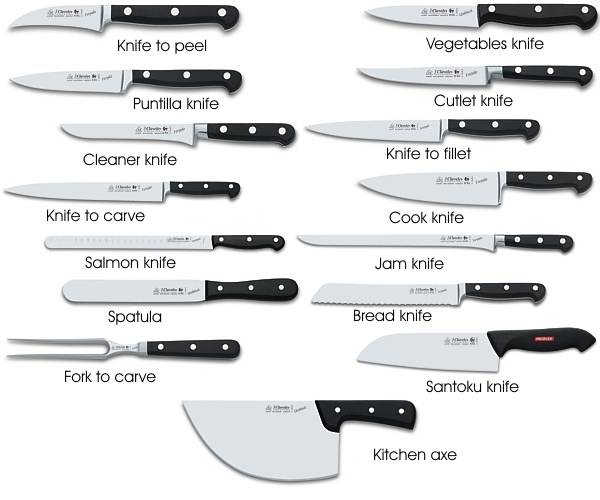
Contrary to what some of us may believe, kitchen knives are not divided into two basic types - sharp or dull. In reality, kitchen knives are to the kitchen what handsaws are to a woodworking shop. There are numerous types of kitchen knives, each with their own purpose and design. In the same way you wouldn't use a chainsaw to trim a picture frame, you wouldn't use a meat cleaver to peel potatoes, for instance. Each blade performs a specific task, so knowing the different types of kitchen knives can help a cook work more efficiently and safely.
One of the most common kitchen knives used today is called a chef's knife. A chef's knife is used for many of the most basic food preparations tasks in the kitchen. It can chop through most vegetables and fruits, slice through meats and cheeses, and create a fairly fine mince or dice.
Chef's knives are usually sold in different sizes, although the largest and smallest sizes still perform the same tasks well. The different sizes are used to match the size of the knife with the size of the user's hand. Larger chef's knives can be harder to control if you have smaller hands, so be sure to test the grip of any knife for comfort before you add it to your collection.
Another variety of kitchen knife is the carving knife. A carving knife is generally larger than a chef's knife, although their basic shapes can be similar. A carving knife can be very rigid or very flexible, depending on the type of meat it is designed to carve. Carving a large pot roast may require a very rigid blade, while carving pork or fish steaks may require more flexibility. A carving knife is often accompanied by a large two-pronged tool called a carving fork.
On the smaller end of the kitchen knives spectrum is the paring knife. A paring knife's blade is rarely more than four inches long (about 10 cm), making it ideal for peeling and coring fruits and vegetables. A paring knife is also used to create special garnishes and other decorative elements. A paring knife's blade should be kept very sharp to prevent accidents. A dull paring knife can cause the user to place too much pressure on the blade, leading to slips and cuts.
Some kitchen knives are designed to prevent food preparation disasters. Many people find slicing through a loaf of bread to be an exercise in futility. This is why many cooks keep a long serrated knife on hand.
A serrated knife works much like a crosscut saw in woodworking. Instead of slicing through the hard crust and soft interior of a bread loaf, a serrated knife's blade makes a series of short saw cuts instead. Without the serrations, a regular knife blade would slide smoothly across the top of the crust without penetrating it. Some fibrous vegetables and fruits also benefit from a serrated knife's crosscutting design.
For removing bones from meats, many cooks uses narrow-bladed kitchen knives called boning knives. A boning knife is usually larger than a paring knife, with a rigid blade that tapers off to a point. It is used to carve out any remaining bones in red meats or to completely debone a whole chicken. A boning knife's narrow blade allows the user to cut around bones without excessive waste. A cousin to the boning knife, called a filet knife, is much more flexible and allows the user to remove skin from fish.
One of the largest kitchen knives is the cleaver. A cleaver has a very heavy, thick blade for cutting through the thickest portions of meat or bones. Despite its imposing size, however, it can also be used for fine chopping and dicing. Cooks can also use the flat side of a cleaver to crush garlic cloves, whole spices or seeds. A cleaver's flat blade can also be used to transfer chopped ingredients to the cooking area.
Other kitchen knives are more specialized, but they all serve a purpose. An oyster knife can penetrate the hard shell of oysters and clams and slice through the tendons holding the sections together. A deveining knife has a small, thin blade designed to remove the gritty vein found in raw shrimp, while simultaneously slicing through the shell. Other specialty knives help process grapefruits, slice through hard cheeses, open clam shells, and even carve steam holes for chestnuts.
What are Different Types of Kitchen Knives?
Posted by Catur Setiawan | 8:39 PM | knives, type | 7 comments »
Subscribe to:
Post Comments (Atom)











Your sense of humor as you write is superb, and infectious! I'm linking to your article as THE reference point in my Squidoo lens on slashers when it goes live, later today!
Great read! I will come back for more :)
ceramic knife
This is a great post about kitchen knives. Thank for share it here! my kitchen knives review
I am happy to read your article.
Thanks for share the article.
Thank you so much.
he said
Your article is really good. I need to buy some steak knives for my kitchen, please give some more tips and safety about knives. I have one link which tells the top products of knives, Can u suggest me some Best Steak Knives so that i can buy for my kitchen.
Thank you for your visit us and comments
Slice with precision using our Professional Kitchen Knives collection!